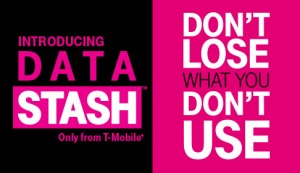T-Mobile to provide data rollover for its mobile services
Article 
T-Mobile Data Stash: You Can Finally Get Rollover for Your Data Plan | Gizmodo
From the horse’s mouth
T-Mobile USA
Press Release – Data Stash – Don’t Use Don’t Lose (English / Espagnol PDF)
My Comments
 Most mobile and fixed broadband services that implement data allowances in their business models have it that you forfeit any of the bandwidth that you don’t use in these plans. This works against an increasingly-common practice of people buying data plans for these services with more data allowance than they really use. This same practice applies to just about all of the mobile providers who provide included talk-time and messaging allowance whether as a combination of talk-time minutes and text / MMS messages or a known value of service use.
Most mobile and fixed broadband services that implement data allowances in their business models have it that you forfeit any of the bandwidth that you don’t use in these plans. This works against an increasingly-common practice of people buying data plans for these services with more data allowance than they really use. This same practice applies to just about all of the mobile providers who provide included talk-time and messaging allowance whether as a combination of talk-time minutes and text / MMS messages or a known value of service use.
But T-Mobile, a spinoff of Deutsche Telekom who is selling mobile telephony and mobile broadband to the US market, is working against this norm. Here, they are marketing this option as “Data Stash” because of the way you can harbour the unused data and work with all of their plans that have an allowance of 3Gb or more. Even existing customers can use this feature which is unlike some carriers who will offer tasty features only to those who start a new account. This is part of their “Uncarrier” program where they offer extra service options and value that other mobile-phone carriers in the USA don’t normally offer.
Here, they offer a “rollover” option for their data plans where if you don’t use all of your data allowance, the unused allowance is carried over to the next month just like what would happen with a bank account. T-Mobile have understood this reality with people buying more than they need and may be needing to satisfy a usage peak, which can be brought on by a change in living conditions, a holiday or simply attending a “big-time” event.
Personally, I would see this as being important with people who use a “Mi-Fi” device like the Samsung LTE Mobile Hotspot Pro or T-Mobile 4G LTE Hotspot Z915 on an occasional basis or use these devices increasingly through certain peaks like summer. But I also see this as a way simply to smooth out the peaks in your mobile-broadband data use and other carriers around the world should have a look at T-Mobile’s offerings to know how to gain the competitive edge.

